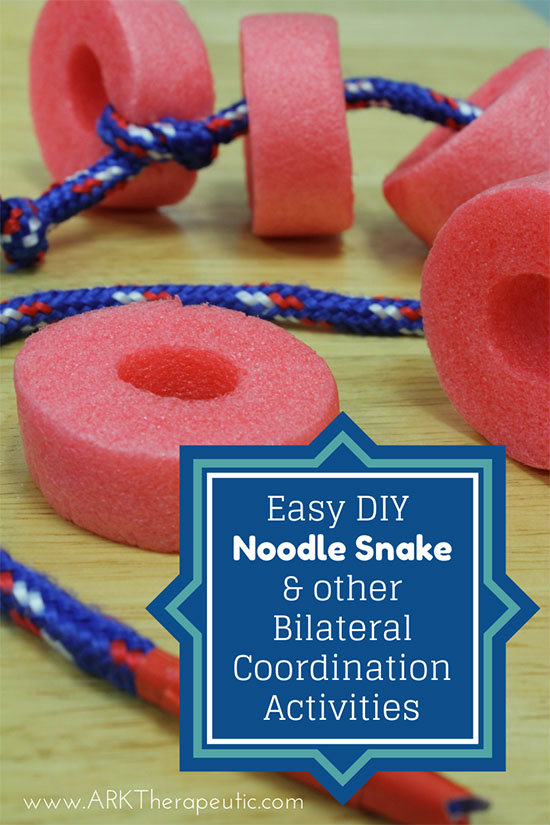DIY Noodle Snake & Fun Activities for Bilateral Coordination
23rd May 2014
Simply put, bilateral coordination is the ability to use both sides of your body together in an organized, coordinated manner. Most children pick up this skill naturally, but sometimes there can be a disconnect. Why is this a problem? Most of what we do on a daily basis involves bilateral coordination: tying shoelaces, typing, opening a water bottle, playing, writing, etc. So only being able to use one hand at a time can be very limiting.
Luckily, since so many activities require bilateral coordination, there are endless opportunities for you to work on this skill both in therapy and at home:
.
GET COOKING
The kitchen is definitely a "both hands" kind of place. Roll out dough with a rolling pin. This is an easy activity to start with because it's symmetrical, and the pin acts as a guide. Mix something in a bowl - stir with one hand and stabilize the bowl with the other. Chop foods - hold the knife in one hand and stabilize the food with another. If necessary, give them softer foods to start with, as these will be easier to cut through (cheese, bananas, steamed veggies, etc.). Curious Chef makes a blunt knife that's designed to be safe for kids.
.
GET ACTIVE
Swimming, jumping, hopscotch, and sports in general - all require both sides of the body to move at the same time, working together.
.
GET CRAFTY
With art projects, the dominant hand will do most of the work, but the other hand also works as a stabilizer. For example, you manipulate scissors with one hand, while the other hand holds the paper. Pinterest is a great resource for craft ideas. As a bonus, many of these crafts double as fine motor activities.
.
GET TO PLAY
Build sand castles. Manipulate putty or hide objects in putty for the hands to find. Stretch pop toobs in and out. Play with pop beads, slinkies, or lacing toys. Thread beads onto pipe cleaners, pasta onto necklaces, or… make your own pool noodle snake:
.

.
This is a very easy DIY bilateral tool that will be in your "bag of tricks" for years. You'll need: heavy rope, pool noodle, and duct tape.
.
1. Cut the rope to approximately 30 inches in length (you can go a bit longer, but making the length longer than your child's reach may make the activity too challenging).
2. Cut the pool noodle into 1 to 2 inch sections. You can cut as many pieces as will fit on the rope, but typically 6-8 is just fine.
3. Tie one end of the rope into a knot; it needs to be big enough so that the noodles can't slide over it. You can also loop the rope through one of the noodle pieces and then tie a knot - this will act as the anchor / stopper for the other pieces.
4. Wrap duct tape around the opposite end of the rope to prevent it from fraying. Layering the tape 3 inches down the rope will also make a more stable end to assist your child in guiding the rope into the noodle.
5. Encourage children to take each noodle piece in their right hand and thread it onto the 'snake'. Once all of the pieces are on the snake, have them pull each piece off, one at a time with their right hand. Then flip the game around and have them do the same with their left hand.
.
With this activity (and any other), watch to make sure that the child is utilizing their "helper hand" - the non-dominant hand that is assisting (the hand that holds a water bottle while you open it, or a piece of paper while you write). Tell the child that this is their "helper hand" so that you can verbally cue them to "use your helper hand!" If necessary, touch the elbow of the helper arm for a tactile cue or use hand over hand assistance. Keep reminding them to use it until bilateral coordination becomes motor memory, and their body remembers that their hands must work together.
.
Have patience, keep practicing, and most importantly - have fun!
.

